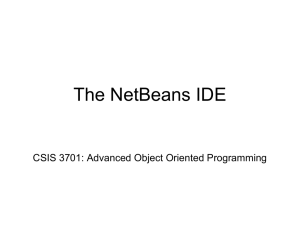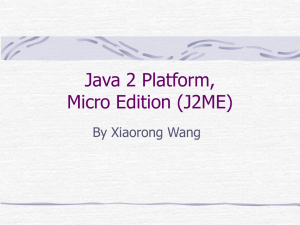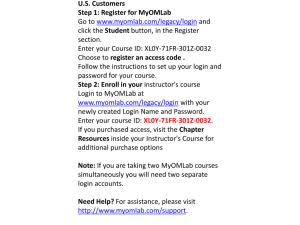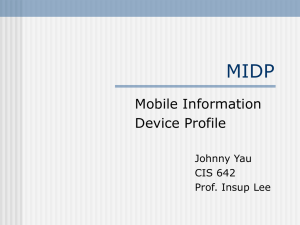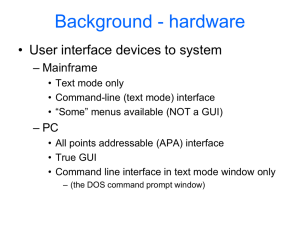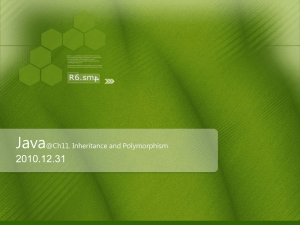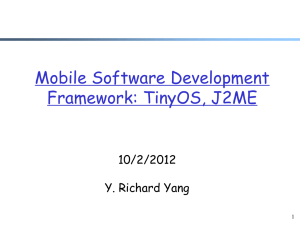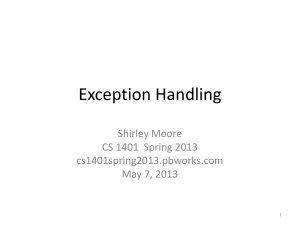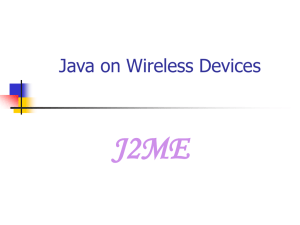slides - Electrical and Information Technology
advertisement
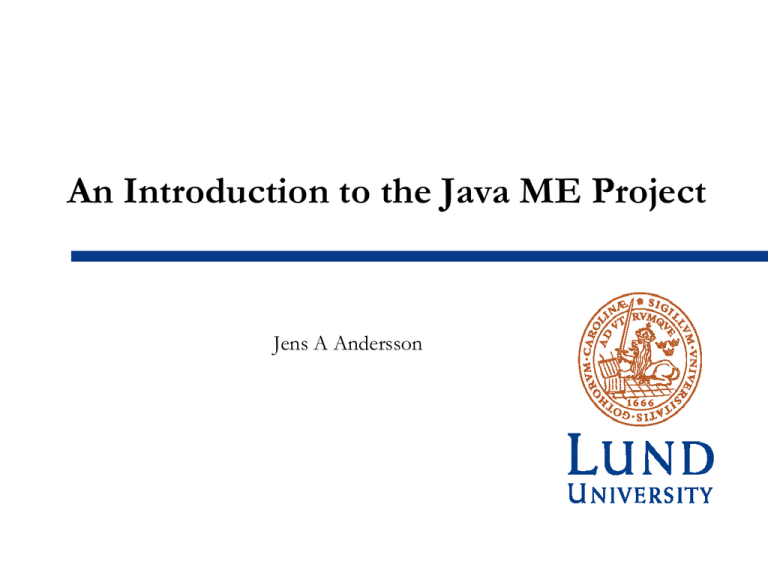
An Introduction to the Java ME Project
Jens A Andersson
Agenda
Java ME
MIDlets
NetBeans
Your task: The Application
Simple Session Protocol and SSPServer
SSP help classes
Why Threads
2/12
Java ME
Sun groupes its Java technologies into 3 editions:
•
•
•
Java EE (Java Enterprise Edition) - servers
Java SE (Java Standard Edition) – personal computers
Java ME (Java Micro Edition) – mobile phones and PDAs
In this course we will use:
•
MIDP (Mobile Information Device Profile)
•
•
MIDP 1.0, 2.0, and 2.1 – backward compatible
CDLC (Connected Limited Device Configuration)
•
CLDC 1.0 and 1.1 – backward compatible
3/12
MIDlets
An application written for MIDP is called a MIDlet.
All MIDlets extend the MIDlet class:
• public class MyMIDlet extends MIDlet { }
The MIDlet class provides methods for starting, pausing,
and terminating the MIDlet application:
• startApp()
• pauseApp()
• destroyApp(boolean unconditional)
The department has four Sony Ericsson K700 phones that
support MIDP 2.0.
4/12
A Complete MIDlet Example
import javax.microedition.midlet.*;
import javax.microedition.lcdui.*;
public class HelloMIDlet extends MIDlet {
public void startApp() {
TextBox textBox = new TextBox(“My MIDlet", "Hello world :=)",15,0);
Display.getDisplay(this).setCurrent(textBox);
}
public void pauseApp() { }
public void destroyApp(boolean unconditional) { }
}
5/12
NetBeans
NetBeans is a free and open-source IDE (Integrated
Development Environment) for developing Java applications.
NetBeans runs on Windows, Linux, Mac OS, etc.
It has support for CLDC 1.0/1.1 and MIDP 1.0/2.0/2.1.
With NetBeans you can write, emulate, and debug
applications for mobile phones. So they contain all you
need to develop Java ME applications.
6/12
Application (overview)
Peer-to-peer application:
Of your choice
Minimum: Simple chat application
Two mobile devices communicate and
exchange messages
Session server (hub/proxy) to find
other party
Application (considerations)
Hub to find other party
NAT makes it impossible to communicate directly
between mobile devices
Proxy for two-way communication (tunnelling)
Application (figure)
NAT!
Global addresses
Private addresses
Private addresses
NAT & PAT
NAT = Network Address Translation
PAT = Port and network Address Translation
zFigure 19.27
Translation
Alternative:
Source address
200.24.5.8 goes
here
Simple Session Protocol
SSP
UDP based
Control messages
Data/Tunnel messages
The SSPServer
SSP (Simple Session Protocol) is a simple protocol
developed for this course.
SSPServer is a Java SE application and allows mobile phones
to communicate to each other through a server.
Two ways of using the SSPServer:
• Download and run it locally on any computer – connect your
application to port 3333 on localhost
• No downloading needed - connect your mobile phone to port 3333
on sspserver.eit.lth.se (public address)
13/12
SSPServer
Users login/logout
Holds a list of active users/opponents
Controls state also on clients
Reacts only on incoming packets
(no time outs)
Forwards application data to other party
TUNNEL
SSP packet format
TYPE ID (1)
DATA (variable)
TYPE ID
CONTROL
0x01
• (The following data is control data)
TUNNEL
0x02
• (The following data is application data)
Control Header Format
TYPE ID (1)
CTRL TYPE ID (1)
USER ID (8)
PEER ID (8)
0x01
CTRL TYPE ID
LOGIN REQ
0x11
• (The user logs in with the specified user id)
LOGIN ACC
0x12
• (The user login is accepted by the hub)
LOGIN REJ
0x13
• (The user login is rejected by the hub)
LOGIN ERR
0x1f
• (Server in LOGIN state but receives ctrl packet for other state)
Control Header Format (cont)
TERMINATE REQ
0x21
• (The user/hub terminates and is logged out)
SETUP LST REQ
0x04
• (The user requests a list over available opponents from the hub)
SETUP LST RES
0x05
• (The hub sends a list with available opponents)
Control Header Format (cont)
SETUP REQ
0x01
• (The user requests the specified user as an opponent)
SETUP ACC
0x02
• (The user accepts request from other user)
SETUP REJ
0x03
• (The user rejects request from other user)
These ctrl packets are forwarded by the hub to the
users.
Peer lists
CONTROL HEADER
(16)
NBR PEERS (1)
PEER1
(8)
SETUP LST RES
List of available opponents
From Hub to mobile device
PEER2 (8)
PEER3 (8)
...
Tunnel Header Format
TYPE ID (1 )
RESERVED (1 )
USER ID (8)
PEER ID (8)
DATA (variable)
0x02
USERID = you; PEERID = opponent
Your application protocol goes in the DATA
field
Application Sequence
Login to server
If accepted
get user list
select peer
request session with peer
If accepted
Start ”application” and data transfer in tunnel
At end logout from server
SSP Java class
Methods for datagram
Parse request
Build request
Validate request
See API on project web page for details
http://www.eit.lth.se/index.php?id=javame
ByteString Java Class
Application data type = String
DatagramConnection (sending/recieving UDP
datagram) uses byte[ ]
ByteString: ”interface” between String and byte[ ]
See API on course home page for details
Application protocol
Data transfer in UDP based tunnel
Best effort!
Application shall handle errors!
Time outs
Packet loss
Packet out of sequence
How? You decide!
Select/Design error handling method
Tunnel Header Format
TYPE ID (1 )
RESERVED (1 )
USER ID (8)
PEER ID (8)
DATA (variable)
0x02
Your application protocol goes in the DATA
field
Applications protocol (cont.)
Is control information needed?
Keep track of messages/datagrams/packets?
How is DATA field interpreted?
…
This is your task for section 2
GUI
GUI is handled by main thread
inhibited when waiting for response in your
methods
Send REQ, Get response
Wait for move from opponent
GUI events must be handled!
An application
“The Application”
MyMIDlet
startApp
commandAction
An application (cont.)
“The Application”
MyMIDlet
startApp
GUI
“stalled”
commandAction
.
.
wait for response
.
An application (cont..)
“The Application”
MyMIDlet
startApp
GUI
active
commandAction
.
.
wait for response
in thread
.
Threads (cont.)
Send REQ
application waiting for GPRS setup?
application waiting for free GPRS slots?
application sending datagram?
GUI blocked until Send REQ is completed
Threads (cont..)
Get Response
application setup GPRS etc?
application waiting for incoming datagram?
application waiting for response from opponent?
GUI blocked until Get Response request is
completed
Threads (cont…)
Do in parallel thread
Send REQ
Get Response
In main thread
Wait for completion of parallel threads
Handle GUI exceptions
Get Started!
1) Visit the home page of the project:
http://www.eit.lth.se/index.php?id=javame
2) Download the SSPServer and run it locally.
3) Download the skeleton code and run it.
4) Study and understand the structure of the skeleton
code.
36/12
